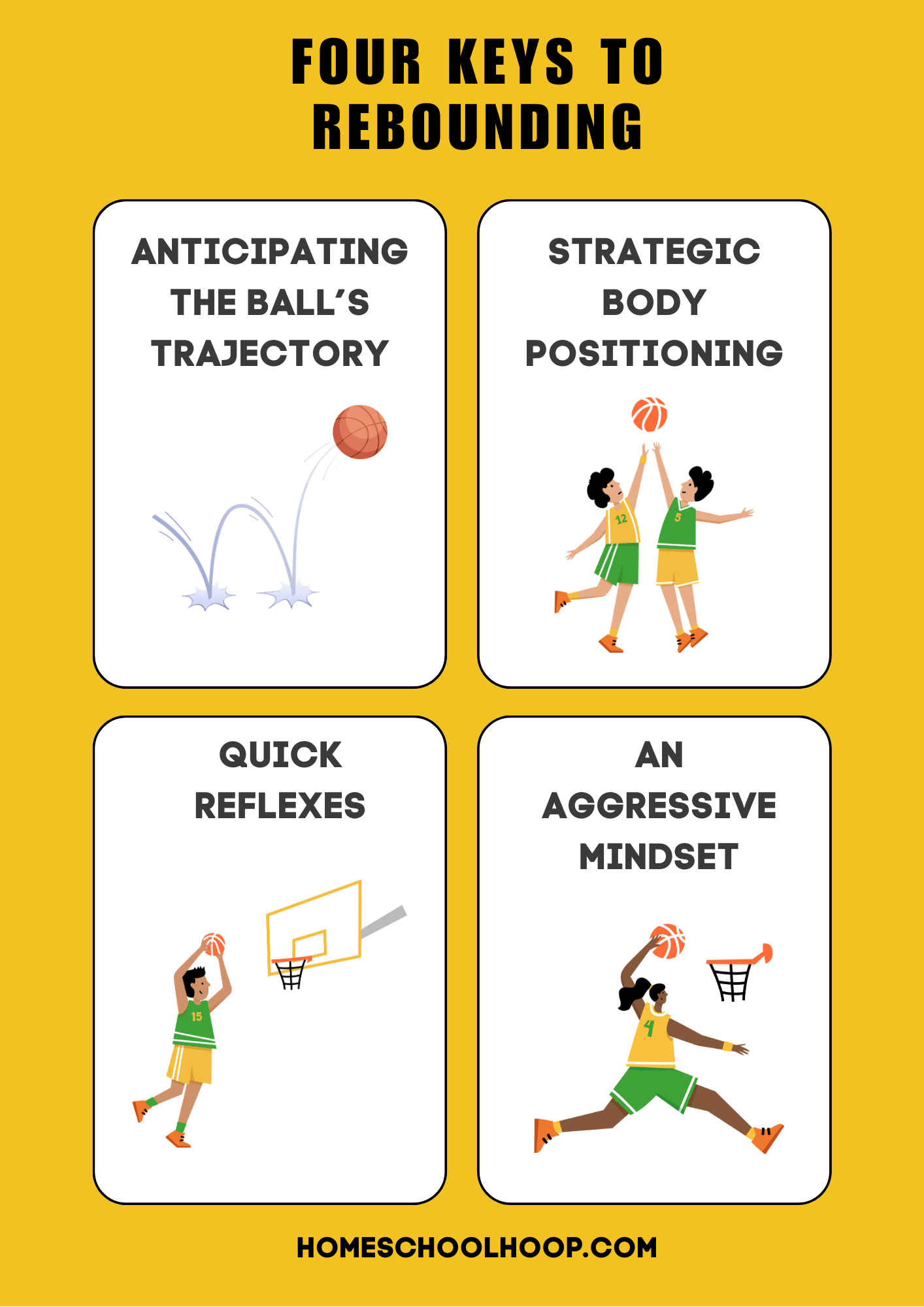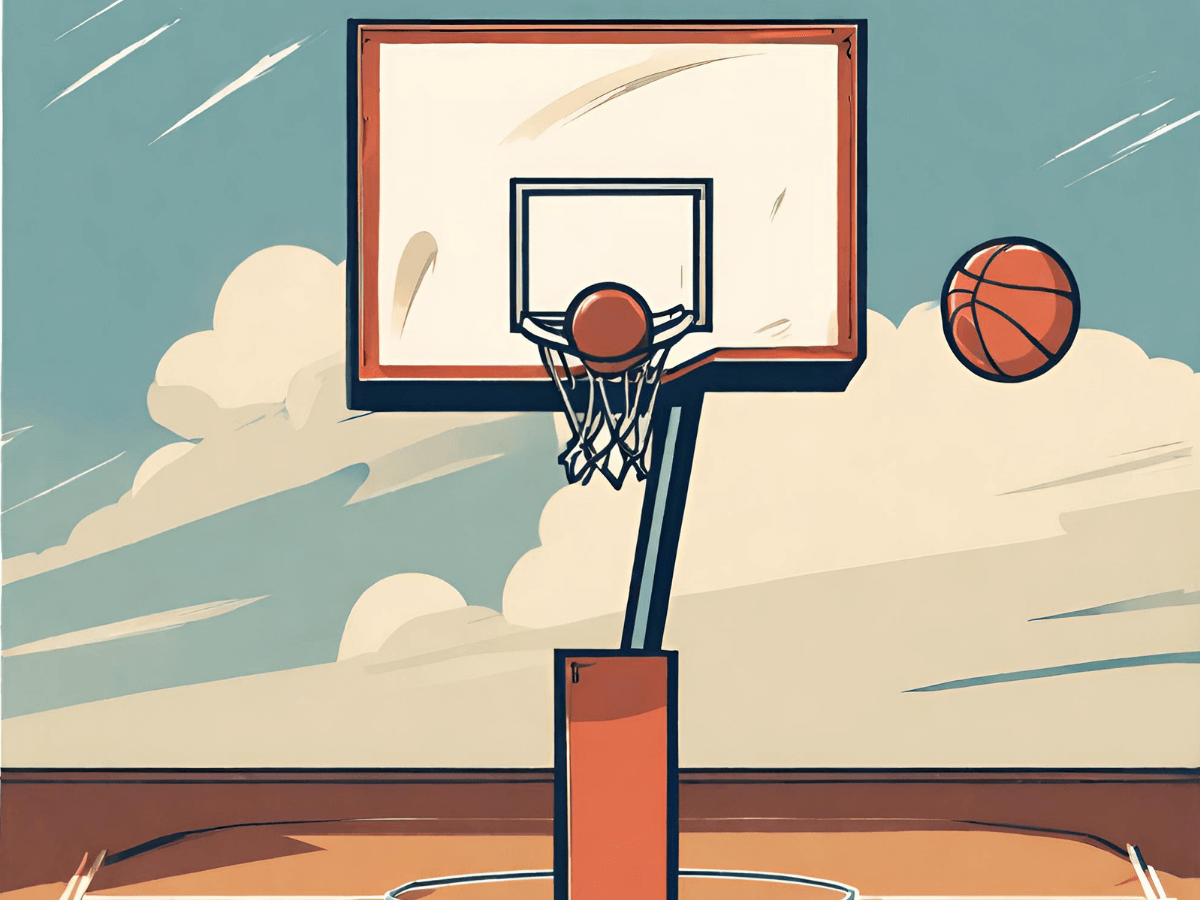Ask any top basketball coach the most essential element of a team’s success, and nearly everyone will answer – rebounding. The great Pat Summitt once said, “Offense sells tickets, defense wins games, rebounding wins championships.”
A rebound in basketball occurs when a player retrieves the ball after a missed shot attempt, either a field goal or a free throw.
Key takeaways:
- A rebound in basketball is successfully gaining possession of the basketball after a missed field goal or free throw.
- Rebounds play a pivotal role in a team’s offensive and defensive success.
- You can significantly boost your rebounding efficiency using specific techniques, drills, and mindset adjustments.
Even the best shooting teams miss roughly 60 percent of their shots. So, rebounding isn’t just nice to have; it’s a critical skill for teams to get more scoring opportunities than their opponents. That’s why players who dominate at rebounding will always earn time on the floor.
Whether you’re a budding player or a fan looking to understand the nuances of basketball better, you’ll receive insight into the rebound meaning, its impact on every game, and actionable tips to enhance your rebounding skills.
What are Rebounds in Basketball?
Understanding what is a rebound in basketball goes beyond just retrieving a missed shot; it’s recognizing its role as a pivotal moment that immediately shifts the game’s momentum.
Whenever a player shoots and misses, the ball is up for grabs. The player on the floor who seizes the opportunity to secure possession for their team has successfully executed a rebound.
It’s a skill that requires:
- Anticipating the ball’s trajectory
- Strategic body positioning
- Quick reflexes
- And most importantly, an aggressive mindset
Every rebound is a small victory, a chance to launch a counterattack and shift the momentum in your team’s favor, or earn your team another opportunity at scoring in that moment.

Types of Rebounds
Whether snatching a second scoring opportunity or wresting control from the opponents, offensive and defensive rebounds are integral to maintaining or gaining momentum in a basketball game.
Offensive Rebounds
An offensive rebound is when a player retrieves the ball after a missed shot attempt from their team. It gives the offensive team another opportunity to score, keeping the ball in their possession and resetting the shot clock. Essentially, it’s a second chance to score.
Offensive rebounds are more challenging than defensive rebounds because the defensive players are often in a more advantageous position when a shot goes up.
Defensive rebounds
On the other end, a defensive rebound is secured by a player from the defending team after an opponent misses a shot. This type of rebound is crucial for stopping the offensive team’s momentum and shutting down their chances at scoring with that possession. It’s about limiting the offensive team to a single shot to regain control of the ball.
Learn more: How tall is a basketball hoop?
The Impact of Rebounds
Rebounds are a cornerstone in basketball, often unfairly serving as the unsung hero that can change the course of a game. The benefits of rebounding are multifaceted, influencing both the offensive and defensive aspects of play.
Offensive Rebounding Benefits
Securing an offensive rebound means the team retains possession of the ball after a scoring attempt, granting them additional chances to score. The impacts of offensive rebounds include:
- More scoring opportunities: Each offensive rebound equates to another shot at the basket, increasing the team’s scoring potential.
- Pressure on the defense: Offensive boards force the opposing team to defend continuously, wearing them mentally and physically down.
- Game momentum: Capturing offensive rebounds boosts a team’s morale and momentum, often leading to increased energy and performance. Opponents who give up offensive rebounds often feel defeated.
Defensive Rebounding Benefits
On the flip side, defensive rebounds are about regaining control and shifting from a defensive mindset to an offensive attack. The impacts of defensive rebounds are:
- Limiting opponent opportunities: By securing a defensive rebound, a team effectively limits the opponents’ scoring opportunities.
- Fast breaks: Defensive rebounds allow for quick transitions to offensive, often leading to more advantageous scoring chances before the defense is fully set up.
- Controlled pace: With the ball in hand, a team can control the game’s pace.
Rebounding Benefits: A Closer Look
Every rebound allows a team to score points or deny the opponent a scoring chance. But rebounds are not just about ball possession. The play a significant impact on a game’s rhythm and results through:
- Game control: Teams that dominate the rebounding stat often dictate a game’s tempo, establishing control.
- Better game strategies: Rebounds lead to more possessions, allowing a team to execute their offensive game plan more effectively.
- Higher chance of winning: A strong rebounding team often earns more wins because of the critical role rebounds play in a game’s outcome.
Learn more: What is a double double in basketball?
How to Become a Better Rebounder
Rebounding isn’t just about height and leaping ability; it’s also about technique, timing, and positioning.
Great rebounders like Wilt Chamberlain and Sylvia Fowles mastered the art of body positioning and anticipating where misses would land. They were tall and had the instincts, strength, and aggression to be in the right place at the right time to secure rebounds.
Of course, height is beneficial for rebounding. The tallest NBA players and tallest WNBA players have a rebounding advantage. Still, even shorter guards can become excellent rebounds with the right skill set and mindset.
Techniques to Master
Three of the primary skills to become good at getting a rebound in basketball include:
- Anticipation: Predict where the ball will land or how it will come off the rim by watching the shooter’s form and trajectory.
- Positioning: While the shot is in the air, get into an optimal spot to grab the rebound. It’s about angles and distance, being close enough to beat everyone else to the ball yet far enough to react.
- Boxing out: When defensive rebounding, position yourself between your opponent and the basket to gain a rebound advantage. You also want to use your body to shield or block opponents to have a clear path to the rebound.
Rebounding Drills and Exercises
Every drill should become an opportunity to improve your rebounding skills. Any time a player shoots, there’s an opportunity for you to practice positioning, boxing out, anticipation, and a rebounding mindset. The best way to become a better rebounder in basketball is to emphasize it in all the drills you participate in.
These types of drills can also help you rebound in basketball:
- Timing drills: Mikan drills and practicing tipping the ball against the backboard and securing it enhances hand-eye coordination and timing.
- Box out drills: Engage in drills that focus on boxing out your opponents effectively, a crucial skill for defensive rebounds.
- Jumping exercises: Plyometric drills, strength training exercises, and learning proper jumping techniques can help improve your vertical leaping ability to snatch more boards.
Learn more: Does playing basketball make you taller?
Developing a Rebounding Mindset
A rebounding mentality is arguably the most crucial to becoming a great rebounder. The common denominator to all good rebounders is a desire to rebound. When it comes to a rebounding mindset, you want to look for:
- Aggressiveness: Great rebounders take an aggressive yet controlled approach. You may even need to be a little fiery because rebounding can be physically tough. So, be determined to go get the ball at every opportunity.
- Focus: How often do you see a player turn and watch a shot go up, only for their opponent to beat them to the ball? Stay alert and remember to rebound every time. Every missed shot is a potential rebound; staying ready is half the battle.
Iconic Rebounders in Basketball History
Watching the greats is another way to learn the art of rebounding.
Wilt Chamberlain leads the rebound history books in the NBA with 23,924 rebounds. The ‘Big Dipper’ used his size, strength, and physicality to dominate on the boards. Most importantly, he had an aggressive approach to rebounding, as shown in this battle for the rebound against Bill Russell.
On the WNBA side, Sylvia Fowles is the all-time leading rebounder with 4,007 rebounds. She was known for her grit, passion, and will to rebound. She was aggressive on the boards and fearless in using physicality to get into a better rebounding position.
Leading WNBA Rebounders in 2023
The table below highlights the top 5 WNBA rebounders of 2023, showcasing players who have mastered the art of controlling the boards.
| PLAYER | TEAM | REBOUNDS PER GAME |
| Alyssa Thomas | Connecticut | 9.9 |
| A’ja Wilson | Las Vegas Aces | 9.5 |
| Breanna Stewart | New York Liberty | 9.3 |
| NaLyssa Smith | Indiana Fever | 9.2 |
| Teaira McCowan | Dallas Wings | 9.1 |
Learn more: Top 10 A’ja Wilson Shirts
Leading NBA Rebounders in 2022-2023
In the 2022-2023 NBA season, a select group of players stood out for their skills in securing rebounds. Below is a table featuring the top 5 NBA rebounders of the 2022-2023 season.
| PLAYER | TEAM | REBOUNDS PER GAME |
| Domantas Sabonis | Sacramento Kings | 12.3 |
| Nikola Jokic | Denver Nuggets | 11.8 |
| Giannis Antetokounmpo | Milwaukee Bucks | 11.8 |
| Rudy Gobert | Minnesota Timberwolves | 11.6 |
| Clint Capela | Atlanta Hawks | 11.0 |
| Nikola Vucevic | Chicago Bulls | 11.0 |
Learn more: What is the average NBA height?
FAQ
What does a rebound mean in basketball?
A rebound is the act of retrieving the ball after a missed shot.
Why is rebounding important in basketball?
Rebounding is essential because it gives teams additional scoring opportunities, limits opponents’ scoring opportunities, and helps control the game’s tempo.
How do you get rebounds in basketball?
You get rebounds by mastering the art of boxing out your opponent, enhancing your jumping ability, and developing an aggressive mindset.
How many points do you get for getting a rebound?
Rebounds don’t directly award points but provide additional scoring opportunities because they increase the number of possessions for your team.
What is a team rebound?
A team rebound is when a team gains possession of the ball after a missed shot that a single player never possesses. Examples include a ball that deflected out of bounds after the shot or a ball blocked out of bounds.

